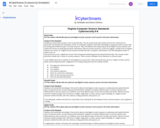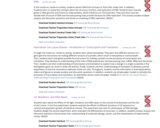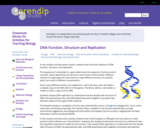
English Instructional Plan – Grades 9- 12: Current Events Persuasive Debate and Essay
- Subject:
- English
- Reading
- Material Type:
- Lesson Plan
- Author:
- VDOE Project Team
- Date Added:
- 04/20/2022

English Instructional Plan – Grades 9- 12: Current Events Persuasive Debate and Essay

Developing a curve of best fit for dataMathematics Instructional Plans (MIPs) help teachers align instruction with the 2016 Mathematics Standards of Learning (SOL) by providing examples of how the knowledge, skills and processes found in the SOL and curriculum framework can be presented to students in the classroom.

Collecting and analyzing data, using curve of best fit Mathematics Instructional Plans (MIPs) help teachers align instruction with the 2016 Mathematics Standards of Learning (SOL) by providing examples of how the knowledge, skills and processes found in the SOL and curriculum framework can be presented to students in the classroom.

Determining a curve of best fit Mathematics Instructional Plans (MIPs) help teachers align instruction with the 2016 Mathematics Standards of Learning (SOL) by providing examples of how the knowledge, skills and processes found in the SOL and curriculum framework can be presented to students in the classroom.

Students will learn about cyber security and keeping their information safe. They will then create a presentation for younger students to teach them about cyber security.

Students will identify and work to solve various cyber security concerns by answering a rEnglishted prompt and working through the problem.

The lessons provided are presented by Scholastic and sponsored by Norton Lifelock.
All rights reserved by Scholastic.
Below is an overview of the three lessons provided.
The lessons do not coincide with one another.
The teacher can choose to use all three or select the best option for the classroom needs.
The PDF Links includes:
Lesson 1: Understanding Online Safety (45 minutes)
- Students will analyze text, citing evidence and summarizing central ideas. They will make inferences to create their own cybersecurity protection plan.
- Students will use the provided copy of #Cybersmarts student magazine to create their personalized online protection plan.
Lesson 2: Identifying Preventive Technologies (45 minutes + presentation time)
- Students will conduct research on preventive technologies built and used by professionals in the cybersecurity field (e.g., firewalls, ad blocker apps, antivirus software, voice recognition software, virtual private network (VPN), etc.).
- Students will then prepare a presentation - the given choices are a skit or interview. Presentation options can be easily adapted to best fit your classroom needs.
- Research planning/ gathering page is provided.
Lesson 3: Making Online Profiles More Secure (2 part lesson - 90 minutes total)
- Students will use analytical and reasoning skills to identify areas of vulnerability in an online profile and come up with strategies for how to make them more secure by applying information from a text.
- First, students will analyze their own personal profiles (if applicable). Then, they will analyze a provided “profile” to identify security holes. Last, discuss the answers and reasonings as a class.
*This lesson can be shortened to fit into one class period.
*(Optional) An extension idea is provided. It includes information from all lessons. Students will use what they have learned to create their own cybersecurity device.

In this lesson, students will learn about why their personal information is important and how they can keep it safe. They will also learn to pull out other people’s personal information and how that character/person can keep it safe.

TSW research different careers within cybersecurity to come up with an answer to the SOL Prompt “Many schools have partnerships with local companies and organizations that allow students to explore certain professions. Write a letter to the manager of a local workplace that performs the type of work that you would like to pursue. Convince the employer to allow you to visit. Include details about why you chose that workplace and the specific job.” After we have created and drafted a sample essay as a class, students will brainstorm, create a foldable/graphic organizer or outline of their ideas, and write their own response to the prompt question. As this is focused heavily on writing and modeling I recommend using this lesson in Q1 or Q2 (at the latest).

In this lesson, students will review the development of the Constitution. To experience what this might be like, students will work together to create a set of rules, procedures, rights, and responsibilities needed to safely use computing devices and networks in our school. When they have finished they will compare their list to the school’s Acceptable Use Policy.

Students will use predetermined materials to create prototypes of badge covers to try to block RFID signals from being read.

This activity introduces cybersecurity concerns with technologies commonly used in the livestock industry in the context of a "clue" style activity in which students act as private investigators looking for a lost racehorse. It can be facilitated in 90 minutes, either in a single session or 4-5 shorter sessions. This activity is part of the Agricultural Cyberbiosecurity Education Resource Collection that contains resources for formal and non-formal agricultural educators working with middle school aged youth. Published as Open Educational Resources, all resources are provided in durable (pdf) and customizable (MS Word) formats. They are hosted on GoOpenVA in a unique resource collection, Ag Cybersecurity Virginia Tech, at https://goopenva.org/curated-collections/143 and on on Virginia Tech’s stable repository, VTechWorks at https://doi.org/10.21061/cyberbiosecurity

This activity would be a great start to a unit on weather. Ideally, students should create their weather instruments and use them to gather data over a period of at least several days, looking for trends in the weather such as temperature and cloud cover. Show the weather PowerPoint to introduce weather tools and terms. Divide students into teams of 3 or 4 to create one of the tools. The following day, students should use the weather tool they create to take and record measurements using the “Weather Data Sheet." Repeat this process several times over several days (or even weeks).

In this activity, students extract DNA from Archaea or from their cheek cells. Students learn key concepts about DNA function during the intervals required for the extraction procedure. Student understanding of DNA structure, function and replication is further developed by additional analysis and discussion questions and hands-on modeling of DNA replication. This activity helps students meet the Next Generation Science Standards.

Students are tasked with creating a model of DNA, which they then photograph and include a written explanation of how the model represents DNA.

Students are tasked with creating a model of DNA and include a typed explanation of how it represents DNA.

This analysis and discussion activity can be used to introduce your students to key concepts about DNA structure, function and replication or to review these topics. This activity includes hands-on modeling of DNA replication.

Science Instructional Plans (SIPs) help teachers align instruction with the Science Standards of Learning (SOL) by providing examples of how the content and the scientific and engineering practices found in the SOL and curriculum framework can be presented to students in the classroom.

The student will learn a dance and identify the pattern, then create a dance routine in both repeating and growing patterns. Students will also understand and identify simple loops.

The students will collaboratively create a dance using the Dance Party Hour of Code Activity.